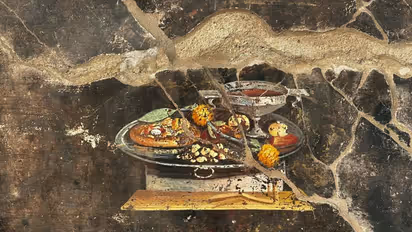Unbelievable! 2000-year-old 'pizza' painting discovered in Italy's Pompeii - WATCH

Synopsis
Archaeologists in the ancient Roman city of Pompeii have uncovered a 2000-year-old painting which depicts what might be the precursor to the Italian pizza.
In the ancient Roman city of Pompeii, archaeologists have discovered a painting that appears to show an early version of the Italian pizza. According to Italy's culture ministry, the flatbread shown in the 2,000-year-old fresco "may be a distant ancestor of the modern dish." However, it isn't exactly a pizza because it doesn't have the traditional elements.
During recent excavations at the southern Italian site, the painting was discovered in the hall of a residence next to a bakery.
The find was made this year during fresh excavations of Regio IX in Pompeii's core, one of the ancient site's nine districts.
After being largely excavated in the 19th century, work on the building resumed in January of this year, over two thousand years after the volcanic eruption that destroyed the city.
The recently discovered fresco, which shows flatbread painted next to a wine goblet, may have been served with fruits like pomegranates or dates or spiced up with a pesto-like sauce, according to archaeologists at the Unesco World Heritage site.
A "frugal and simple meal" and the "luxury of silver trays" are contrasted, according to Pompeii director Gabriel Zuchtriegel.
"How can we fail to think, in this regard, of pizza, also born as a 'poor' dish in southern Italy, which has now conquered the world and is also served in starred restaurants," he said.
A statement from the culture ministry revealed that three other people's skeletons had just been discovered in the working parts of the house, close to the oven.
When Mount Vesuvius erupted in AD 79, ash engulfed Pompeii, trapping the city's inhabitants in place. Since it was discovered in the 16th century, the location has been a valuable resource for archaeologists.
The location is located approximately 23 kilometres (14 miles) from Naples, the current location of the Italian pizza that is protected by the Unesco.
Check the Breaking News Today and Latest News from across India and around the world. Stay updated with the latest World News and global developments from politics to economy and current affairs. Get in-depth coverage of China News, Europe News, Pakistan News, and South Asia News, along with top headlines from the UK and US. Follow expert analysis, international trends, and breaking updates from around the globe. Download the Asianet News Official App from the Android Play Store and iPhone App Store for accurate and timely news updates anytime, anywhere.